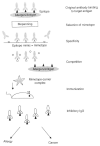Mimotope vaccination--from allergy to cancer
- PMID: 19344285
- PMCID: PMC3049225
- DOI: 10.1517/14712590902870386
Mimotope vaccination--from allergy to cancer
Abstract
Background: Mimotopes are peptides mimicking protein, carbohydrates or lipid epitopes and can be generated by phage display technology. When selected by antibodies, they represent exclusively B-cell epitopes and are devoid of antigen/allergen-specific T-cell epitopes. Coupled to carriers or presented in a multiple antigenic peptide form mimotopes achieve immunogenicity and induce epitope-specific antibody responses upon vaccination.
Objective/methods: In allergy IgG antibodies may block IgE binding to allergens, whereas other IgG antibody specificities enhance this and support the anaphylactic reaction. In cancer, inhibitory antibody specificities prevent growth signals derived from overexpressed oncogenes, whereas growth-promoting specificities enhance signalling and proliferation. Therefore, the mimotope concept is applicable to both fields for epitope-specific vaccination and analysis of conformational B-cell epitopes for the allergen/antigen.
Results/conclusions: Mimotope technology is a relatively young theme in allergology and oncology. Still, proof of concept studies testing allergen and tumour mimotope vaccines suggest that mimotopes are ready for clinical trials.
Figures


Similar articles
-
IgE mimotopes of birch pollen allergen Bet v 1 induce blocking IgG in mice.Int Arch Allergy Immunol. 2001 Jan-Mar;124(1-3):395-7. doi: 10.1159/000053768. Int Arch Allergy Immunol. 2001. PMID: 11307026
-
Mimotope vaccines: epitope mimics induce anti-cancer antibodies.Immunol Lett. 2007 Oct 31;113(1):1-5. doi: 10.1016/j.imlet.2007.07.008. Epub 2007 Aug 22. Immunol Lett. 2007. PMID: 17825923 Free PMC article. Review.
-
Monovalent fusion proteins of IgE mimotopes are safe for therapy of type I allergy.FASEB J. 2001 Nov;15(13):2524-6. doi: 10.1096/fj.00-0888fje. Epub 2001 Sep 17. FASEB J. 2001. PMID: 11641259
-
Vaccination with a human high molecular weight melanoma-associated antigen mimotope induces a humoral response inhibiting melanoma cell growth in vitro.J Immunol. 2005 Jan 15;174(2):976-82. doi: 10.4049/jimmunol.174.2.976. J Immunol. 2005. PMID: 15634921
-
Phage display peptide libraries in molecular allergology: from epitope mapping to mimotope-based immunotherapy.Allergy. 2016 Nov;71(11):1526-1532. doi: 10.1111/all.12965. Epub 2016 Jul 15. Allergy. 2016. PMID: 27341497 Review.
Cited by
-
AllergoOncology - the impact of allergy in oncology: EAACI position paper.Allergy. 2017 Jun;72(6):866-887. doi: 10.1111/all.13119. Epub 2017 Jan 23. Allergy. 2017. PMID: 28032353 Free PMC article. Review.
-
Bacteriophage-Based Vaccines: A Potent Approach for Antigen Delivery.Vaccines (Basel). 2020 Sep 4;8(3):504. doi: 10.3390/vaccines8030504. Vaccines (Basel). 2020. PMID: 32899720 Free PMC article. Review.
-
Advances in phage display based nano immunosensors for cholera toxin.Front Immunol. 2023 Sep 13;14:1224397. doi: 10.3389/fimmu.2023.1224397. eCollection 2023. Front Immunol. 2023. PMID: 37781379 Free PMC article. Review.
-
Blocking peptides and molecular mimicry as treatment for kidney disease.Am J Physiol Renal Physiol. 2017 Jun 1;312(6):F1016-F1025. doi: 10.1152/ajprenal.00601.2015. Epub 2016 Sep 21. Am J Physiol Renal Physiol. 2017. PMID: 27654896 Free PMC article. Review.
-
Immune Response and Outcome of High-Risk Neuroblastoma Patients Immunized with Anti-Idiotypic Antibody Ganglidiomab: Results from Compassionate-Use Treatments.Cancers (Basel). 2022 Nov 25;14(23):5802. doi: 10.3390/cancers14235802. Cancers (Basel). 2022. PMID: 36497290 Free PMC article.
References
-
- Lebecque S, Dolecek C, Laffer S, et al. Immunologic characterization of monoclonal antibodies that modulate human IgE binding to the major birch pollen allergen Bet v 1. J Allergy Clin Immunol. 1997;99(3):374–84. [• This paper describes the capability of IgG antibodies of enhancing IgE binding to Bet v 1.] - PubMed
-
- Yip YL, Smith G, Koch J, et al. Identification of epitope regions recognized by tumor inhibitory and stimulatory anti-ErbB-2 monoclonal antibodies: implications for vaccine design. J Immunol. 2001;166(8):5271–8. [• This study shows that anti-HER-2 antibodies, dependent on the targeted epitope, can either inhibit or stimulate tumour growth.] - PubMed
-
- Bauchau V, Durham SR. Prevalence and rate of diagnosis of allergic rhinitis in Europe. Eur Respir J. 2004;24(5):758–64. - PubMed
-
- Cohen SG, Frankland AW, Dworetzky M. Noon and Freeman on prophylactic inoculation against hay fever. J Allergy Clin Immunol. 2003;111(5):1142–50. - PubMed
-
- Durham SR, Walker SM, Varga EM, et al. Long-term clinical efficacy of grass-pollen immunotherapy. N Engl J Med. 1999;34l(7):468–75. [• This study shows that immunotherapy of grass-pollen allergy induces prolonged clinical remission and a persistent alteration in immunologic reactivity.] - PubMed
Publication types
MeSH terms
Substances
Grants and funding
LinkOut - more resources
Full Text Sources
Other Literature Sources
Medical
